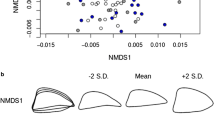Abstract
The present study tested the separate and the interactive pollution effects of cadmium and mercury on the electrophoretically detected allelic isozyme frequencies of the enzyme phosphoglucose isomerase for two species of littoral marine gastropods —Littorina punctata andL. neritoides — and the enzyme amino peptidase forL. neritoides. Our results indicate differential survivorship of allelic isozyme genotypes specific for each type of pollutant and for their interaction, as well as trends common to all pollutants. Theoretically the results reflect the adaptive nature of at least some allozymic genotypes in these marine gastropods and seem inconsistent with the neutral theory of allozyme polymorphisms. Practically, the results reinforce earlier conclusions that changes in the frequency of allelic isozymes may be used as a genetic monitor of pollution.
Similar content being viewed by others
Literature cited
Bailey, N. J. J. 1959. Statistical methods in biology. English University Press, London, pp. 38–39.
Ben-Shlomo, R., and E. Nevo. 1987. Isozyme polymorphism as monitoring of marine environments: the interactive effects of cadmium and mercury pollution in the shrimpPalaemon elegans. (Submitted for publication toEnvironmental Monitoring and Assessment.)
Clarke, B. 1979. The evolution of genetic diversity.Proceedings of the Royal Society of London [B] 205:453–474.
El-Nady, F. E. 1986. Bioaccumulation of mercury in some coastal marine fish from Alexandria waters. FAO Fisheries Report 325 supplement (papers presented at the FAO/ UNEP/WHO/IOC/IAEA meeting on the biogeochemical cycle of mercury in the Mediterranean, Siena, Italy, 27–31 August 1984).
Kimura, M. 1983. The neutral theory of molecular evolution. Cambridge University Press, Cambridge, UK.
Lavie, B., and E. Nevo. 1986a. The interactive effects of cadmium and mercury pollution on allozyme polymorphisms in the marine gastropodCerithium scabridum.Marine Pollution Bulletin 17:21–23.
Lavie, B., and E. Nevo. 1986b. Genetic selection of homozygote allozyme genotypes in marine gastropods exposed to cadmium pollution.Science of Total Environment 57:91–98.
Milstein, C. 1961. Inhibition of phosphoglucomutase by trace metals.Biochemical Journal 79:591–596.
Nei, M. 1975. Molecular population genetics and evolution. North-Holland, Amsterdam.
Nevo, E., T. Perl, A. Beiles, D. Wool, and U. Zoller. 1980. Genetic structure as a potential monitor of marine pollution.Workshop on Pollution of the Mediterranean, United Nations Environment Program, Cagliari, October 9–13, pp 61–68.
Nevo, E., T. Perl, A. Beiles, and D. Wool. 1981. Mercury selection of allozyme genotypes in shrimps.Experientia 36:1152–1154.
Nevo, E., B. Lavie, and R. Ben-Shlomo. 1983. Selection of allelic isozyme polymorphisms in marine organisms: pattern, theory and application.Isozymes 10:69–92.
Nevo, E., R. Ben-Shlomo, and B. Lavie. 1984. Mercury selection of allozymes in marine organisms: prediction and verification in nature.Proceedings of the National Academy of Science USA 81:1258–1259.
Powers, D. A., G. S. Greaney, and A. R. Place. 1979. Physiological correlation between dehydrogenase genotype and haemoglobin function in Killi fish.Nature 277:240–241.
Roth, I., and H. Hornung. 1977. The concentration of heavy metals (Hg, Cd, Pb, Cr, Cu, Zn and Ni) in streams and estuaries in the central and northern area of Israel.Environmental Science and Technology 11:265–269.
Ruivo, M. 1972. Marine pollution and the sea life. Fishing News, London.
Selander, R. K., M. H. Smith, S. Y. Yang, E. W. Johnson, and G. B. Gentry. 1971. Biochemical polymorphism and systematics in the genusPeromyscus. I. Variation in the old field mouse (Peromyscus polionotus).University of Texas Publications 1103:49–90.
Siegel, S. 1956. Nonparametric statistics for the behavioral sciences. Academic Press, New York.
United Nations Environment Program. 1980.Workshop on Pollution of the Mediterranean, Cagliari, October 9–13, p 225.
Wills, C. 1981. Genetic variability. Clarendon, Oxford, UK.
Author information
Authors and Affiliations
Rights and permissions
About this article
Cite this article
Lavie, B., Nevo, E. Differential fitness of allelic isozymes in the marine gastropodsLittorina punctata andLittorina neritoides, exposed to the environmental stress of the combined effects of cadmium and mercury pollution. Environmental Management 11, 345–349 (1987). https://doi.org/10.1007/BF01867162
Issue Date:
DOI: https://doi.org/10.1007/BF01867162




